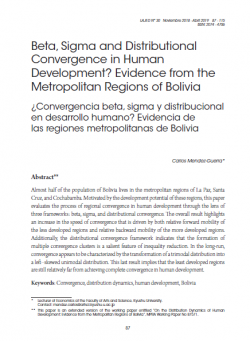Beta, Sigma and Distributional Convergence in Human Development? Evidence from the Metropolitan Regions of Bolivia
DOI:
https://doi.org/10.35319/lajed.20183015Keywords:
Convergence, distribution dynamics, human development, BoliviaAbstract
Almost half of the population of Bolivia lives in the metropolitan regions of La Paz, Santa Cruz, and Cochabamba. Motivated by the development potential of these regions, this paper evaluates the process of regional convergence in human development through the lens of three frameworks: beta, sigma, and distributional convergence. The overall result highlights an increase in the speed of convergence that is driven by both relative forward mobility of the less developed regions and relative backward mobility of the more developed regions. Additionally, the distributional convergence framework indicates that the formation of multiple convergence clusters is a salient feature of inequality reduction. In the long-run, convergence appears to be characterized by the transformation of a trimodal distribution into a left–skewed unimodal distribution. This last result implies that the least developed regions are still relatively far from achieving complete convergence in human development.
Downloads
References
Abreu, M., H. De Groot and R. Florax. 2005. “A meta-analysis of beta-convergence: The legendary 2 percent”. Journal of Economic Surveys, 19(3):389-420.
Bai, J. and S. Ng. 2004. “A panic attack on unit roots and cointegration”. Econometrica, 72(4):1127-1177.
Barro, R. J. and X. Sala-I-Martin. 1991. “Convergence across states and regions”. Brookings Papers on Economic Activity, 1991(1):107-182.
---------- 1992a. “Convergence”. Journal of Political Economy, 100(2):223-251.
---------- 1992b. “Regional growth and migration: A Japan-United States comparison”. Journal of the Japanese and International Economies, 6(4):312-346.
---------- 2004. Economic growth. MIT Press, Cambridge, Mass.
Bianco, S. D. 2016. “Going clubbing in the eighties: convergence in manufacturing sectors at a glance”. Empirical Economics, 50(2):623-659.
Caballero-Claure, B. and R. Caballero-Martínez. 2016. “Sigma convergencia, convergencia beta y condicional en Bolivia, 1990-2011”. Economía coyuntural, 1(1):25- 59.
De la Fuente, A. 1997. “The empirics of growth and convergence: A selective review”. Journal of Economic Dynamics and Control, 21(1):23–73.
---------- 2000. “Convergence across countries and regions: theory and empirics”. EIB papers, 5(2):25–45.
Epstein, P., P. Howlett and M.S. Schulze. 2003. “Distribution dynamics: stratification, polarization, and convergence among OECD economies, 1870–1992”. Explorations in Economic History, 40(1):78-97.
Evia, J. L., O. Nina, M. Urquiola, L. Andersen and E. Antelo. 1999. “Geography and development in Bolivia: Migration, urban and industrial concentration, welfare, and convergence: 1950-1992”. Inter-American Development Bank, Working Paper 3085.
Gerolimetto, M. and S. Magrini. 2015. “Spatial distribution dynamics”. European Regional Science Association, Conference Paper 1172.
Henderson, D. J. and C. F. Parmeter. 2015. Applied Nonparametric Econometrics. Cambridge University Press, Cambridge.
Islam, N. 2003. “What have we learnt from the convergence debate?” Journal of economic surveys, 17(3):309-362.
Johnson, P. A. 2000. “A nonparametric analysis of income convergence across the us states”. Economics Letters, 69(2):219-223.
Johnson, P. A. 2005. “A continuous state space approach to convergence by parts”. Economics Letters, 86(3):317-321.
Kar, S., D. Jha and A. Kateja. 2011. “Club-convergence and polarization of states: A nonparametric analysis of post-reform India”. Indian Growth and Development Review, 4(1):53-72.
Kuscevic-Montero, C. and M. Rivera-del Rio. 2013. “Convergencia en Bolivia: Un enfoque espacial con datos de panel dinámicos”. Revista de Economía del Rosario, 16(2):233-256.
Li, Q. and J. S. Racine. 2007. Nonparametric econometrics: Theory and practice. Princeton University Press, New Yersey.
Machicado, C. G., N. B. Nina and L. C. Jemio. 2012. Factores que inciden en el crecimiento y el desarrollo en Bolivia: Análisis nacional y regional (1989-2009). INESAD-PIEB, La Paz.
Magrini, S. 1999. “The evolution of income disparities among the regions of the European Union”. Regional Science and Urban Economics, 29(2):257-281.
---------- 2004. “Regional (di)convergence”. In: J.V. Henderson and J.F. Thisse (ed.) Handbook of regional and urban economics, 4: 2741-2796, Elsevier.
---------- 2009. “Why should we analyse convergence using the distribution dynamics approach?” Scienze Regionali, 8(1):5-34.
Marchante, A. J., & B. Ortega. 2006. “Quality of life and economic convergence across Spanish regions, 1980-2001”. Regional Studies, 40(5), 471-483.
Mendez-Guerra, C. 2017. “Heterogeneous Growth and Regional (Di)Convergence in Bolivia: A Distribution Dynamics Approach”. Economía coyuntural, 2(4):81-108.
Petrakos, G., & Y. Saratsis. 2000. “Regional inequalities in Greece”. Papers in Regional Science, 79(1), 57-74.
Phillips, P. C. and D. Sul. 2007. “Transition modeling and econometric convergence tests”. Econometrica, 75(6):1771-1855.
---------- 2009. “Economic transition and growth”. Journal of Applied Econometrics, 24(7):1153-1185.
Quah, D. 1993. “Galton’s fallacy and tests of the convergence hypothesis”. The Scandinavian Journal of Economics, 95(4), 427-443.
---------- 1996. “Twin peaks: growth and convergence in models of distribution dynamics”. Economic Journal, 106(437), 1045-1055.
---------- 1997. “Empirics for growth and distribution: Stratification, polarization, and convergence clubs”. Journal of Economic Growth, 2(1):27-59.
Royuela, V. and G. A. García. 2015. “Economic and social convergence in Colombia”. Regional Studies, 49(2):219-239.
Sala-i Martin, X. 1996. “The classical approach to convergence analysis”. Economic Journal, pages, 106(437), 1019-1036.
Sandoval, F. 2003. “Situación, tendencias y perspectivas de la convergencia regional en Bolivia 1980-1997”. Working Paper, Banco Central de Bolivia.
Shibamoto, M., Y. Tsutsui and C. Yamane. 2016. “Understanding regional growth dynamics in Japan: Panel co-integration approach utilizing the panic method”. Journal of the Japanese and International Economies, 40:17-30.
Soruco, C. 2012. “Espacio, convergencia y crecimiento regional en Bolivia: 1990-2010”. Working Paper, Banco Central de Bolivia, 01/2012.
UNDP. 2016. El nuevo rostro de Bolivia: transformación social y metropolización. United Nations Development Program, Human Development Report for Bolivia, Bolivia, La Paz.
Wand, M. P. and M. C. Jones. 1995. Kernel Smoothing. Chapman and Hall, London.






